If you work in a lab where you run chemical reactions under reflux conditions, you’ve likely considered the downsides of using water in your condenser. Such experiments heat a solvent to boiling, using a condenser above the reaction vessel to cool and capture the vapour produced, returning it as liquid to the vessel. Traditionally, chemists cool Liebig condensers using flowing water at rates estimated at 1 to 4 litres a minute. This racks up large water bills, wastes a precious resource, and can lead to leaks and floods in your lab. Here’s how you can minimise or even avoid these downsides using alternative methods.
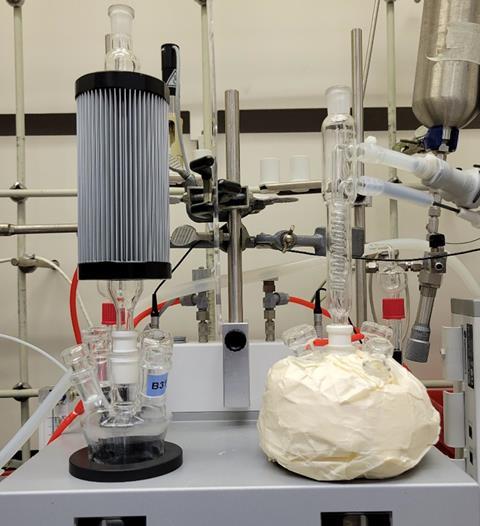
The problem with water-cooled condensers
The wastefulness of water-cooled condensers has become increasingly worrying as water gets scarcer around the world. Continuous consumption of 4l of water a minute equates to over 2 million litres of water wasted per year for a single condenser.
Condensers themselves are also often subject to failure, something most chemists have encountered. Most often the failure happens in the tubing that connects them to their water supply and drain. Over time, the rubber tubing can crack or slide off, especially under pressure, even when using traditional methods of clamping and wiring to prevent leaks. Water pressure can also propel the drain tube out of the sink. In very rare cases, a spike in water pressure can burst the condenser.
Such problems can cause floods that can damage equipment and cause significant disruption, especially if they happen when no-one is in the lab. Often the damage is extensive, soaking cabinets and leaking through into floors below. In a case reported in 2019, a tap left on overnight led to three 325-gallon waste tanks overflowing, causing $27,000 (£21,300) in damage.
Water-cooled condensers that recirculate water
A first step towards reducing costs, water use and the risk of flooding is to use a pump that continually recirculates the same small volume of water. Academic labs often achieve this using cheap pumps like those used to circulate water in aquariums or ponds. Industrial labs often have more specialised and expensive recirculating chillers. However, pumps of all sorts are also still subject to failure and continually use resources, albeit electricity rather than water.
Waterless condenser alternatives
Now, researchers at Merck & Co in Rahway, US, known as MSD in Europe, have been looking at how you can minimise or even avoid these downsides using air-cooled or waterless alternatives. These options reduce the risk of water damage. They’re also much easier to install than liquid cooling alternatives. However, chemists are often concerned that they will lead to too much solvent escaping the reaction vessel, meaning that they would need to repeat experiments.
Until this year most research on waterless condensers has come from their manufacturers. However, these studies don’t test other options such as simple and cheap glass tubes as a comparison. The MSD researchers sought to produce an independent, believable study comparing commercially available condensers to other options such as connecting an existing traditional condenser to an air supply, that might be cheaper or provide a lower barrier-to-entry.
The MSD researchers looked at four different options, assessing their advantages and disadvantages.
How do air-cooled condensers measure up?
1. Plain glass tube
- The simplest, cheapest, option, a plain glass tube that sits on top of the reaction vessel
2. Air-cooled Dimroth condenser
- Uses compressed air instead of water
- Efficiently and cheaply cools by circulating air through an inner coil
3. Vigreux condenser
- Relatively cheap and commonly used with a water-cooled condenser for distillations but can be used without water for reflux
- Features inner spikes and outer dimples that increase surface area
4. Chemglass high-efficiency air condenser and Findenser
- Expensive brand-name waterless condensers designed to cool without water
- Highly efficient with large, exposed surface areas, especially the Findenser, which has aluminium fins
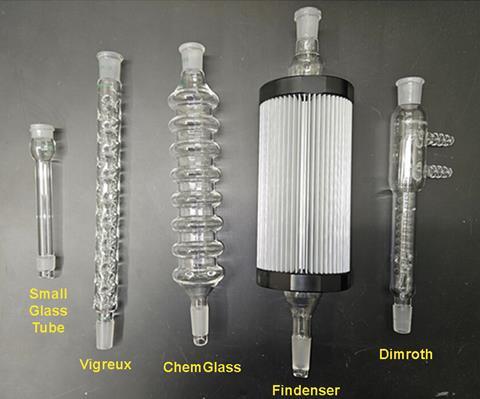
Comparing performance
The MSD team compared these condensers using thermal imaging and solvent weight loss measurements under typical gentle reflux conditions. Reflux experiments typically carefully select solvents so that only gentle reflux is needed. However, the researchers also used another set of conditions where they refluxed the solvents more vigorously to measure the condensers’ failing point.
Here’s what they found:
Gentle reflux: almost any condenser will suffice. The study showed that when operating under mild reflux conditions, even the simplest setups, such as a plain glass tube, provided adequate cooling. This is particularly true when the experimental setup includes insulation to retain heat in the reaction flask, which reduces the cooling load on the condenser.
Vigorous reflux: in the vigorous reflux test the condenser must prevent the solvent from boiling dry. Here, the plain glass tube resulted in the fastest solvent loss, followed by the Vigreux and Chemglass high-efficiency air condenser. The air-cooled Dimroth came next, with the Findenser performing the best. However, labs are more likely to have Dimroth condensers.
The study revealed that the condenser’s outer surface area is crucial to its cooling efficiency. For example, while the Vigreux condenser has increased surface area due to its spikes and dimples, this does not significantly enhance its air-cooling performance compared with its length and exposed surface area. In contrast, the Findenser’s extensive aluminium surface area makes it highly effective.
The paper also discussed the importance of considering the overall design and setup of the condensation system. For instance, ensuring proper airflow can significantly enhance air-cooled condenser performance, with reflux systems working less well outside of fume hoods, or in fume hoods with low air flow.
Putting it into practice
Switching to waterless condensers can help prevent floods and conserve water, letting you confidently run overnight reactions without worrying about water leaks. To spread the word about such options, the authors encourage organic chemistry lab courses to include both water-cooled and air-cooled condensers when introducing reflux to students. By showing that expensive commercial air condensers are not greatly superior to simple glass tubes for gentle reflux, the MSD researchers hope to make this possible.
If you’ve tried out some of these water-free condensers in your lab we’d love to hear from you about how successful they were
References
K Lam et al, ACS Omega, 2024, DOI: 10.1021/acsomega.4c00411







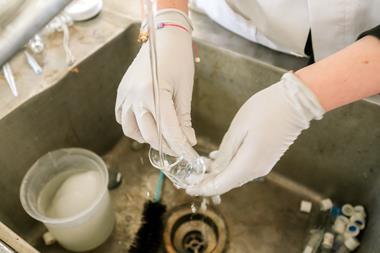

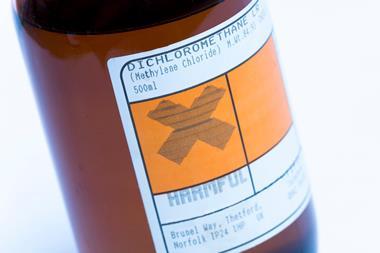
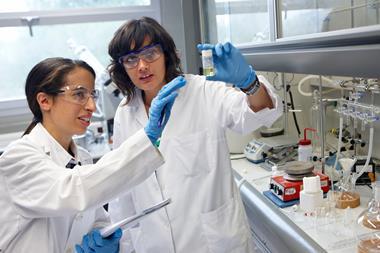






1 Reader's comment